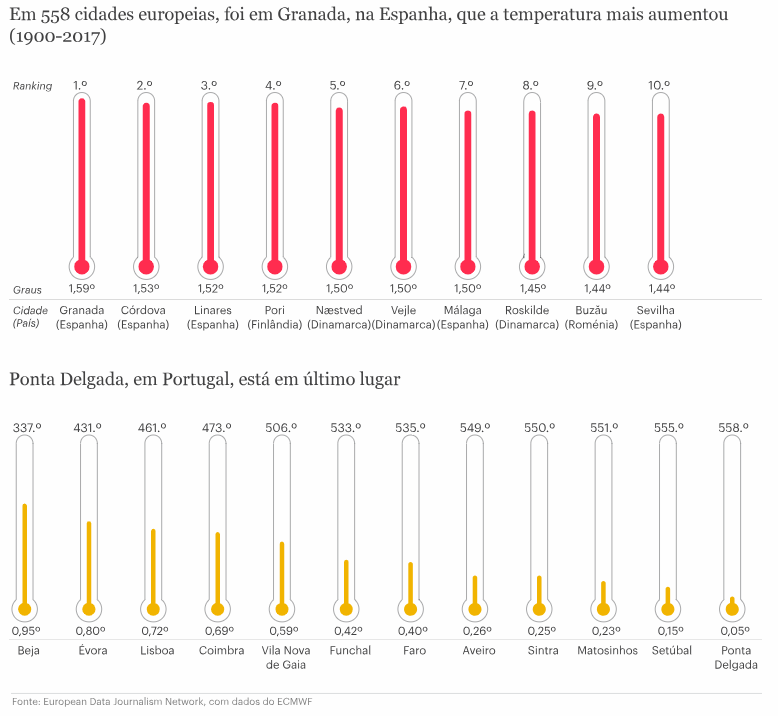European cities are becoming hotter. Portugal is at the bottom of the list
In Évora the temperature rose by almost one degree. Cities in Nordic countries, Eastern Europe and Southern Spain warmed the most.

Beja - Digitalsignal [CC BY-SA 3.0 (https://creativecommons.org/licenses/by-sa/3.0)]
European cities are becoming hotter. Portugal is at the bottom of the list
In Évora the temperature rose by almost one degree. Cities in Nordic countries, Eastern Europe and Southern Spain warmed the most.
Beja – Digitalsignal [CC BY-SA 3.0 (https://creativecommons.org/licenses/by-sa/3.0)]
European cities are, on average, one degree warmer than they were during the last century. At the top of the list is Granada. There, the average temperature in the last seventeen years has soared; it was 1.6°C higher than in the period between 1900 and 1999. Córdoba and Linares, also in Spain, complete the top of the list. Eastern Europe, Southern Spain, Denmark and Finland are among the areas where local thermometers saw the largest increase. Portuguese cities were among those that warmed the least.
These statistics, from the European Centre for Medium-Range Weather Forecasts (ECMWF), were the product of analysis carried out by the European Data Journalism Network of average temperatures registered daily in 558 European cities since 1900. The statistics made available by the ECMWF are drawn from different sources, which are harmonised to enable geographical and historical comparisons. It is the first time that this amount of data has been made available and analysed together.
In Portugal, it was Beja that has heated up the most in the past seventeen years when compared with the average of preceding century. It rose by 0.9°C. Ponta Delgada (the capital of the Azores region) saw the smallest increase, with a rise of 0.1°C. On the mainland, data was also analysed for Évora (+0.8°C), Coimbra (+0.7°C), Lisbon (+0.7°C), Vila Nova de Gaia (+0.6°C), Funchal (+0.4°C), Faro (+0.4°C), Aveiro (+0.3°C), Sintra (+0.2°C) and Setúbal (+0.2°C). Among the Portuguese cities that were studied, the hottest continue to be Funchal and Ponta Delgada, in that order.
These numbers put Portugal at the bottom of the list – five of the twelve Portuguese cities that carried out this work are among the ten European cities that warmed the least – sitting alongside places in Ireland (Limerick, Galway and Waterford), the UK (Derry and Strabane) and the north of Spain (Vigo).
João Camargo, professor of Environmental and Livestock Production Engineering and author of Climate Change Combat Manual said that the fact that Portuguese cities are at the end of the list “is normal”, since “the starting temperatures were already higher and it is normal that temperatures in countries of a higher latitude would rise more”. Incidentally, “the two places where the temperature is going to rise the most are the North and South Poles, because they are the places where the starting point is lower”.
Yet being a smaller rise in comparison with other cities on the list does not stop it from being worrying, says João Camargo. “We started from a much more vulnerable position, meaning every 0.1°C rise matters a lot.” He added: “It is too fast a rise for such a small amount of time.”
This method of comparing the past seventeen years with the last century is not so common in the academic world. “Normally, to assess changes to the climate, we use a scale of thirty years. It is the standard measure. But half of this already gives us more information, especially when it is accelerating so quickly”, expands João Camargo.
The only hotter period in human history was during the Eemian interglacial period, around 130,000 years ago. “There were forests up to the North Cape, far beyond the Arctic Circle, there was no ice in the Arctic in summer, there were hippos in the Rhine and the Thames, Central Europe was a savannah and there were monsoons in North Africa and Arabia, but there were very few of us.”
More hot days
Just as the average temperature increases, so do the hot days. The trend is more or less consistent but there are four cities which contradict it. In the other 554 places analysed, this rise was, on average, four more hot days a year.
The effects of a rise in average temperature on health are already highlighted in various studies. A team of researchers at the University of Coimbra analysed the number of admissions for mental health problems between 2008 and 2014 and their relation to the hottest days. The conclusion: the number of admissions for mental illnesses among residents in the Lisbon Metropolitan Area goes up when temperatures rise beyond 30°C.
Heat also affects the number of deaths registered daily. This year, at the start of August, when thermometers in some parts of Portugal were breaking maximum temperature records, 500 more deaths were registered than normal, according to provisional estimates from the Portuguese General Directory of Health. The 2003 heatwave caused more than 70,000 deaths in Europe.
Even so, the effects of excessive heat will be more intense in areas where the population is not as used to higher temperatures. Data released by the European Environment Agency in its 2016 report on the impact of climate change shows that, in Madrid, for example, fatalities rise when the average daily temperature is higher than 21°C. In Stockholm, thermometers only need to exceed 19°C for a rise in the number of deaths in comparison to days not considered hot.
The daily information made available by the ECMWF, and gathered by EDJNet, provides a slightly greater level of detail. It was possible to analyse the number of hot days during the academic year – these also grew in the majority of cities. In 472 of the 558 places that were analysed, three more hot days, on average, were registered during the academic years between 2000 and 2017 than in the preceding century. In seventy cities the number stayed the same. In the remaining sixteen, the number of days with higher temperatures shrunk during the period of analysis. Spain was the country most affected by this trend.
In every Portuguese city, school days also got warmer. Funchal, for example, experienced almost a week more of hot days than normal in the full academic year. On the relationship between temperature and cognitive performance, a researcher from Harvard University, Jisung Park, analysed data from 4.5 million secondary school exams taken in New York and concluded that doing an exam on a day when the temperature is above 32°C causes a drop in performance of 4.5% – compared with days when the temperature is 22°C.
Furthermore, “being cumulatively exposed to heat during the school year leads to less success in the final exam”, says Park in his study. At the moment, there is no similar study for European students.
The solution must be global
On 11 September, António Guterres, Secretary General of the United Nations, warned that the world has two years to fight against climate change. If not, it risks facing “disastrous consequences”. The leader of the UN argued that the global population should “ask for answers” from the world’s political leaders.
To resolve the problem, it is necessary to understand that we need a “different legal solution to what already exists. We need to understand that the planet is not just a territory. The earth’s systems must exist within the legal international order for the common good, which is within and outside all states.” Someone who agrees with him is the jurist and researcher at the Faculty of Law of the University of Porto, Paulo Magalhães, also President of the ‘Casa Comum da Humanidade’ (Common House of Humanity) – an organisation founded in 2016 to advocate for changing the judicial system to value ecosystems. He also recognises that there is “an enormous urgency” in finding a solution.
Cities and local governments had an important role for mitigation and adaptation, but this “is not resolving the problem”. Taking this into account, he argues, it is necessary to alter “the model of economic growth”. That means “countries can grow by increasing their capacity to protect common environmental interests.”
“We all know that the Amazon is a very important rainforest. Nevertheless, for Brazil to put economic value on what is in this forest, it has to destroy it because the work that the forest does is economically and judicially invisible”, Paulo Magalhães explains.

